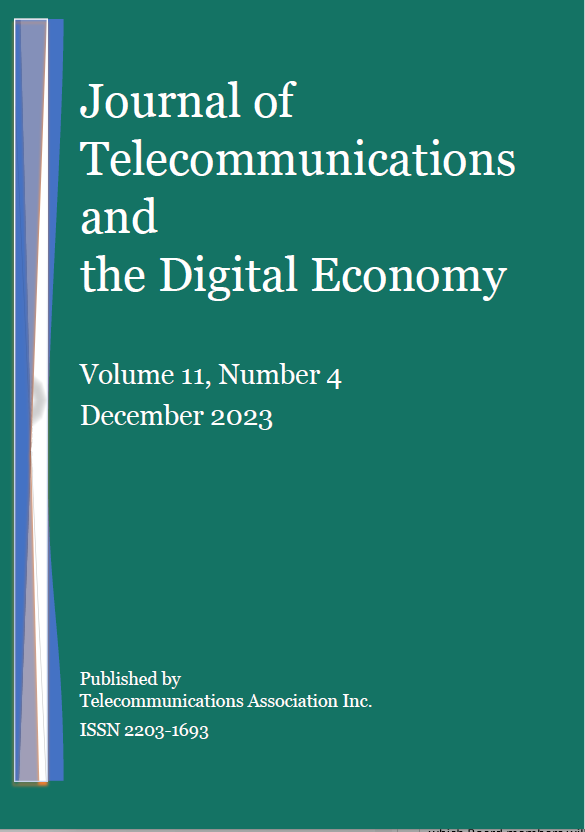Strategies and Challenges of Unified Payment Interface Towards Facilitating a Digital Payments System in India
Main Article Content
Keywords
Unified Payments Interface, digital payments system, polynomial trendline projection
Abstract
The Indian economy is gradually curtailing its overdependence on currency-based transactions and thereby moving closer to digital and mobile-based payment transactions. The main objective of the paper is to provide an in-depth theoretical understanding of the Unified Payments Interface (UPI), its current pace of growth and the possible future penetration based on polynomial trendline projection, the possible challenges that limit future penetration, and the various strategies to overcome these challenges. The paper used the previous six years’ UPI penetration statistics from 2016 to 2017 and established trends using polynomial trendline equation for the purpose of anticipating future penetration. The study also used statistics from published reports of the Reserve Bank of India (RBI) and the National Payment Corporation of India (NPCI) to draw meaningful conclusions on future UPI penetration. The study finds that the targeted one billion UPI transactions per day is achievable. The article contributes towards applied research by providing a decision-making tool to support policymakers, the government, and payment service providers, among others. Strategic applications of this research outcome include Unified Dispute and Issue Resolution processes, the RBI’s lapse management, customer protection measures, UPI limit management, expansion of Internet user base and promoting digital financial inclusion in India.
References
Ahmed, S., & Sur, S. (2023). Change in the uses pattern of digital banking services by Indian rural MSMEs during demonetization and Covid-19 pandemic-related restrictions. Vilakshan – XIMB Journal of Management, 20(1), 166–192. https://doi.org/10.1108/xjm-09-2020-0138
Allam, Z. (2020). The Forceful Reevaluation of Cash-Based Transactions by COVID-19 and Its Opportunities to Transition to Cashless Systems in Digital Urban Networks. In Surveying the Covid-19 Pandemic and its Implications. https://doi.org/10.1016/b978-0-12-824313-8.00008-5
Bagla, R. K., & Sancheti, V. (2018). Gaps in customer satisfaction with digital wallets: challenge for sustainability. Journal of Management Development, 37(6), 442–451. https://doi.org/10.1108/JMD-04-2017-0144
Balakrishnan, M. (2017). Can India get to 25 billion retail digital transactions in 2017–18? Journal of Payments Strategy & Systems, 11(3), 259–274.
BHIM UPI. (2016). UPI Terms And Conditions. https://www.bhimupi.org.in/terms-conditions#:~:text=“Payment Service Provider” or “,and Settlement Systems Act%2C 2007.
Centre for Economics and Business Research (CEBR). (2022). India Tops The World In Real-Time Payment Volumes In 2021. https://cebr.com/reports/inc-42-india-tops-the-world-in-real-time-payment-volumes-in-2021/
Donthu, N., & Gustafsson, A. (2020). Effects of COVID-19 on business and research. Journal of Business Research, 117(June), 284–289. https://doi.org/10.1016/j.jbusres.2020.06.008
Fahad, M. S. (2022). Exploring the determinants of adoption of Unified Payment Interface (UPI) in India: A study based on diffusion of innovation theory. Digital Business, 2(2), 100040. https://doi.org/10.1016/j.digbus.2022.100040
Gochhwal, R. (2017). Unified payment interface-an advancement in payment systems. American Journal of Industrial and Business Management, 7, 1174–1191. https://doi.org/10.4236/ajibm.2017.710084
International Telecommunication Union (ITU). (2020). Individuals using the Internet (% of population) – India. https://data.worldbank.org/indicator/IT.NET.USER. locations=IN
Internet And Mobile Association of India. (2019). Digital in India 2019. In Nielsen. https://cms.iamai.in/Content/ResearchPapers/2286f4d7-424f-4bde-be88-6415fe5021d5.pdf
Kapur, P. K., Sharma, H., Tandon, A., & Aggarwal, A. G. (2020). Studying BHIM app adoption using bass model: An Indian perspective. International Journal of Mathematical, Engineering and Management Sciences, 5(1), 120–135. https://doi.org/10.33889/IJMEMS.2020.5.1.011
Kashyap, H. (2022). UPI targeting 1 bn daily transactions in next 5 years: FM Nirmala Sitharaman. Inc42 Daily Brief. https://inc42.com/buzz/upi-targeting-1-bn-daily-transactions-next-5-years-fm-nirmala-sitharaman/#:~:text=“UPI target is to cross, this number by around 394%25.
KPMG. (2021). Contribution of Smartphones to DIGITAL GOVERNANCE IN INDIA A study by India Cellular & Electronics Association (Issue July). https://icea.org.in/blog/wp-content/uploads/2022/06/ICEA-Digital-Governance-in-India-Report-2020.pdf
Kumar, A., Kar, S. K., & Bansal, R. (2022). The growth trajectory of UPI-based mobile payments in India: Enablers and inhibitors. Indian Journal of Finance and Banking, December, 45–59. https://doi.org/10.46281/ijfb.v11i1.1855
Kuriakose, A., P.B, S., & George, E. (2022). Modelling the consumer adoption intention towards unified payment interface (UPI): An extended UTAUT2 model with relative advantage, add-on services and promotional benefits. 2022 Interdisciplinary Research in Technology and Management (IRTM), 1–7. https://doi.org/10.1109/IRTM54583.2022.9791524
Mallik, P. K., & Gupta, D. (2020). A study on factors influencing consumer intention to use upi-based payment apps in Indian perspective. In Information and Communication Technology for Intelligent Systems (Vol. 2). https://doi.org/10.1007/978-981-15-7062-9_23
National Payments Corporation of India. (2016). Unified Payments Interface (UPI) Product Overview. https://www.npci.org.in/what-we-do/upi/product-overview#:~:text=Unified Payments Interface (UPI) is, merchant payments into one hood.
National Payments Corporation of India. (2022a). UPI Ecosystem Statistics. https://www.npci.org.in/what-we-do/upi/upi-ecosystem-statistics#innerTabThreeOct22
National Payments Corporation of India. (2022b). UPI Live Members. https://www.npci.org.in/what-we-do/upi/live-members
National Payments Corporation of India. (2022c). UPI Product Statistics. https://www.npci.org.in/what-we-do/upi/product-statistics
Pobee, F., Jibril, A. B., & Owusu-Oware, E. (2023). Does taxation of digital financial services adversely affect the financial inclusion agenda? Lessons from a developing country. Digital Business, 3(2), 100066. https://doi.org/10.1016/j.digbus.2023.100066
PWC. (2020). The remarkable rise of UPI in 2020 (Vol. 1, Issue December). https://www.pwc.in/assets/pdfs/consulting/financial-services/fintech/point-of-view/pov-downloads/the-remarkable-rise-of-upi-in-2020.pdf
Rahman, M., Ismail, I., & Bahri, S. (2020). Analysing consumer adoption of cashless payment in Malaysia. Digital Business, 1(1), 100004. https://doi.org/10.1016/j.digbus.2021.100004
RBI. (2021). Annual Report 2020–21. https://m.rbi.org.in/Scripts/AnnualReportPublications.aspx?Id=1293
RBI. (2022). Annual Report 2021–22. https://rbidocs.rbi.org.in/rdocs/AnnualReport/PDFs/9PAYMENTANDSETTLEMENT033C9414C22C4370AD16C837C55EDDC9.PDF
Reserve Bank of India. (2020). Assessment of the progress of digitisation from cash to electronic. In RBI Occasional Paper. https://www.rbi.org.in/Scripts/PublicationsView.aspx?id=19417
Reserve Bank of India. (2022). Money Supply for the fortnight ended October 21, 2022. https://rbi.org.in/Scripts/BS_PressReleaseDisplay.aspx?prid=54640
Saksono, T., & Fulazzaky, M. A. (2020). Predicting the accurate period of true dawn using a third-degree polynomial model. NRIAG Journal of Astronomy and Geophysics, 9(1), 238–244. https://doi.org/10.1080/20909977.2020.1738106
Shaikh, A. A., Hanafizadeh, P., & Karjaluoto, H. (2017). Mobile banking and payment system: A conceptual standpoint. International Journal of E-Business Research, 13(2), 14–27. https://doi.org/10.4018/IJEBR.2017040102
Zhang, J., & Jiang, Z. (2021). A new grey quadratic polynomial model and its application in the COVID-19 in China. Scientific Reports, 11(1), 1–27. https://doi.org/10.1038/s41598-021-91970-1






